The End of Chestnuts? No!
Blight Strikes
I looked up into the tree that I had planted 20 years ago and saw what I had long feared: two major limbs with sparse, undersized leaves. Blight had finally got a toehold on the Colossal chestnut tree, which, for the past 15 years, has supplied us with all the chestnuts we could eat. (“Colossal” is the variety name, apt for the size of the chestnuts it produces.)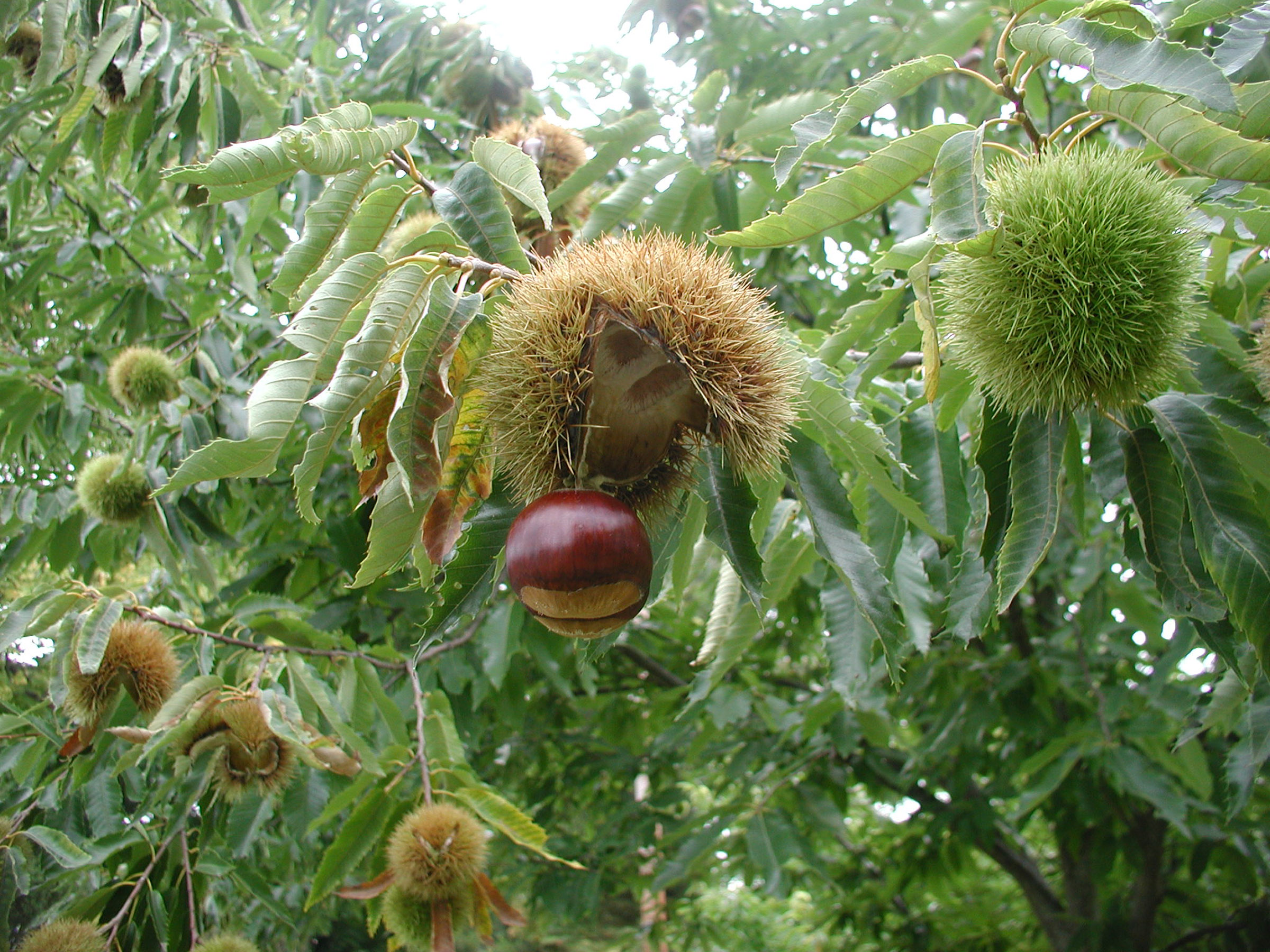 My first inclination, before even identifying chestnut blight as the culprit, was to lop off the two limbs. Once I got up close and personal with the tree, the tell-tale orange areas within cracks in the bark stared me in the face.
My first inclination, before even identifying chestnut blight as the culprit, was to lop off the two limbs. Once I got up close and personal with the tree, the tell-tale orange areas within cracks in the bark stared me in the face.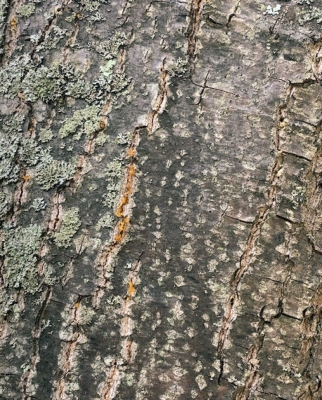 There is no cure for chestnut blight. Removing infected wood does remove a source of inoculum to limit its spread. In Europe, the disease has been limited by hypovirulence, a virus (CHV1) that attacks the blight fungus. Some success has been achieved using a naturally occurring virus found on blighted trees in Michigan.
There is no cure for chestnut blight. Removing infected wood does remove a source of inoculum to limit its spread. In Europe, the disease has been limited by hypovirulence, a virus (CHV1) that attacks the blight fungus. Some success has been achieved using a naturally occurring virus found on blighted trees in Michigan.
There is some evidence, although not confirmed with rigorous scientific testing, that mud packs made from soil taken from the base of a tree, can slow or halt spread of the disease. The mud packs need to be applied to each disease canker and then held in place with shrink wrap, or painted or sprayed on, followed by a layer of latex paint. Not an easy job as you move higher and higher up into the tree.
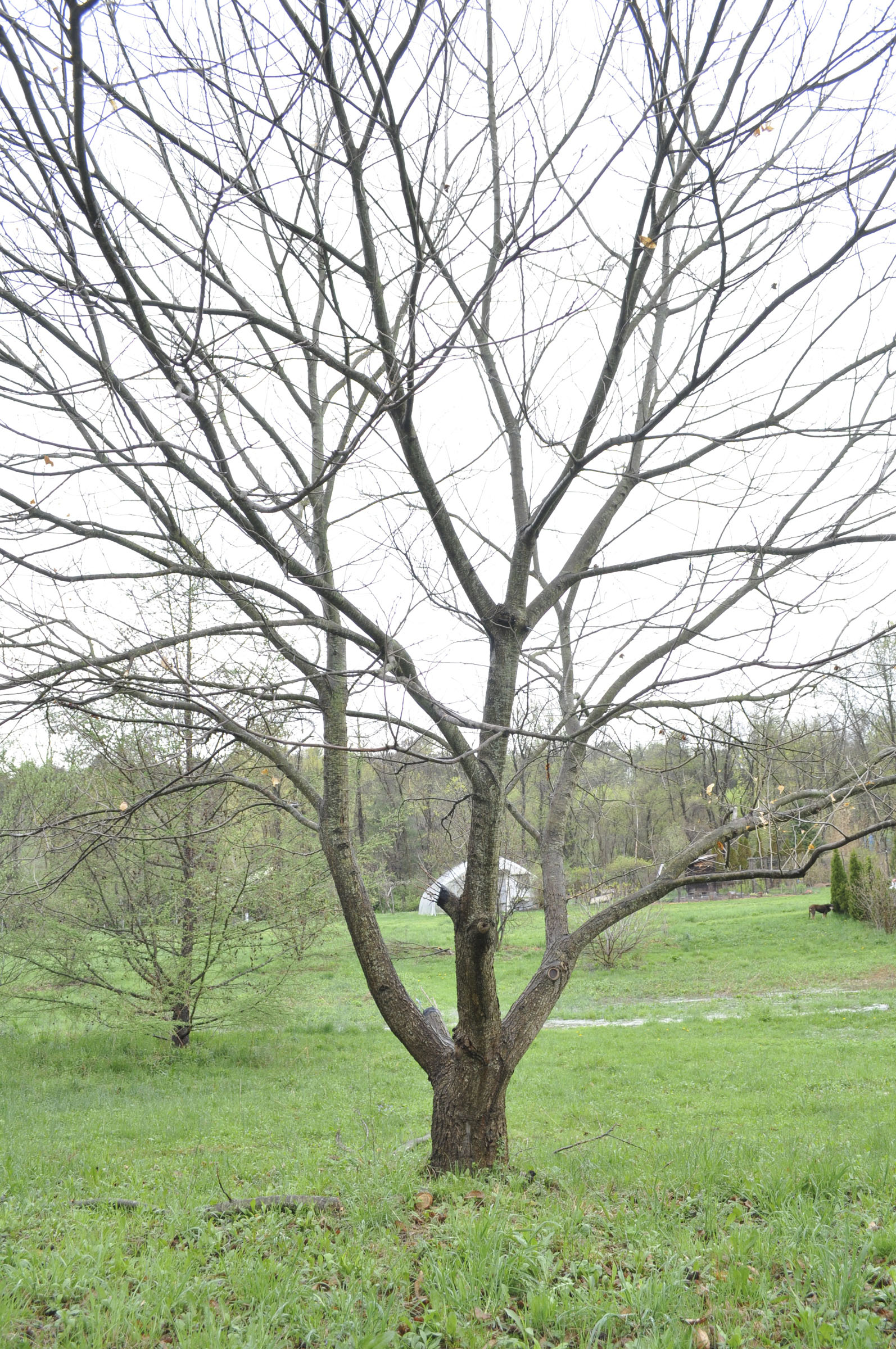
One of my seedling Chinese chestnuts
Resistance
Chestnut species vary in their response to the blight fungus. American chestnut (Castanea dentata) is very susceptible; the fungus arrived here from Asia in the early 1900s, and within a half a century had killed billions of trees. European chestnut (C. sativa) was also susceptible, but was protected by the naturally spreading fungal virus.
Chinese chestnut (C.mollisima) and Japanese chestnut (C. crenata) both have some resistance — but not immunity — to the disease, and have contributed their genes to resistant varieties. Collosal, in fact, is a hybrid of European and Japanese chestnuts, and it has some resistance to blight. But, evidently, not enough. I am hoping that the previously extremely wet season contributed to the evidence of symptoms, and that some drier seasons will keep the tree alive longer.
I’m not planning to sit back and let my chestnut-eating days shrink away to nothing. For starters, keeping my tree vigorous with pruning and good fertility might keep small cracks, into which new infections could enter, from developing. Also, chestnut trees need cross-pollination, so I do have other varieties planted. Also planted 20 years ago was Marigoule, also yielding fairly large nuts. Some sources say “blight susceptible,” others saw “blight resistant;” my large tree shows no signs or symptoms of blight. Yet.
This spring I planted two more European x Japanese chestnut hybrids. I shouldn’t have felt so confident that MY trees wouldn’t get blighted. Precoce Migoule and Marsol, the two varieties I planted, are, like Marigoule, allegedly “blight resistant,” or not.
Generally, the Chinese varieties and their hybrids are the most blight resistance. And I have two of those, actually one tree on which I grafted two different varieties. Qing is pure Chinese with easy-to-peel nuts having excellent flavor. Peach, the other variety, is also pure Chinese, though the nuts are ho-hum in flavor. Both varieties have borne for me for a number of years, yet the nuts never seem ripe once they drop.
One More Thing . . .
Is your head spinning yet? One more wrinkle in this chestnut saga. It turns out that if a pure or hybrid Chinese variety pollinates a pure or hybrid Japanese variety, the latter gets dark staining of the nuts, with a loss in quality. So I was phasing out (with a chainsaw) some other Chinese varieties I had planted. Now, with blight lurking in the wings, I’m having second thoughts.
Enough negativity about chestnuts. On the positive side, Chestnut trees’ shiny, green leaves are attractive and turn a rich golden yellow color in fall. The nuts are tasty and nutritious. With their high starch and low fat content, they’ve been called “the bread tree.” Gluten-free bread tree, for those who care about gluten.
So, do plant chestnuts. Two different varieties for cross-pollination. If I was planting again — and I might — I’d seek out trees from among Qing, Benton Harbor, Everfresh, Gideon, and Mossberger. Or, for Japanese varieties and their hybrids: Maraval, Marigoule, Labor Day, Precoce Migoule, and Marsol.
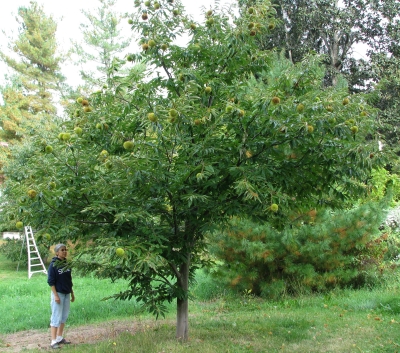
Colossal, at 10 years old
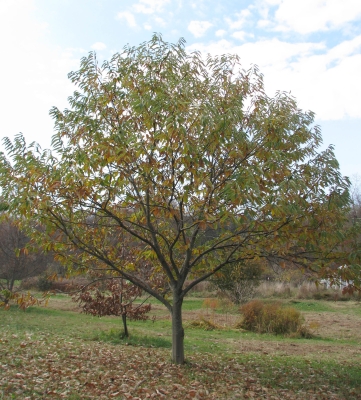
Colossal, in autumn, 12 years old

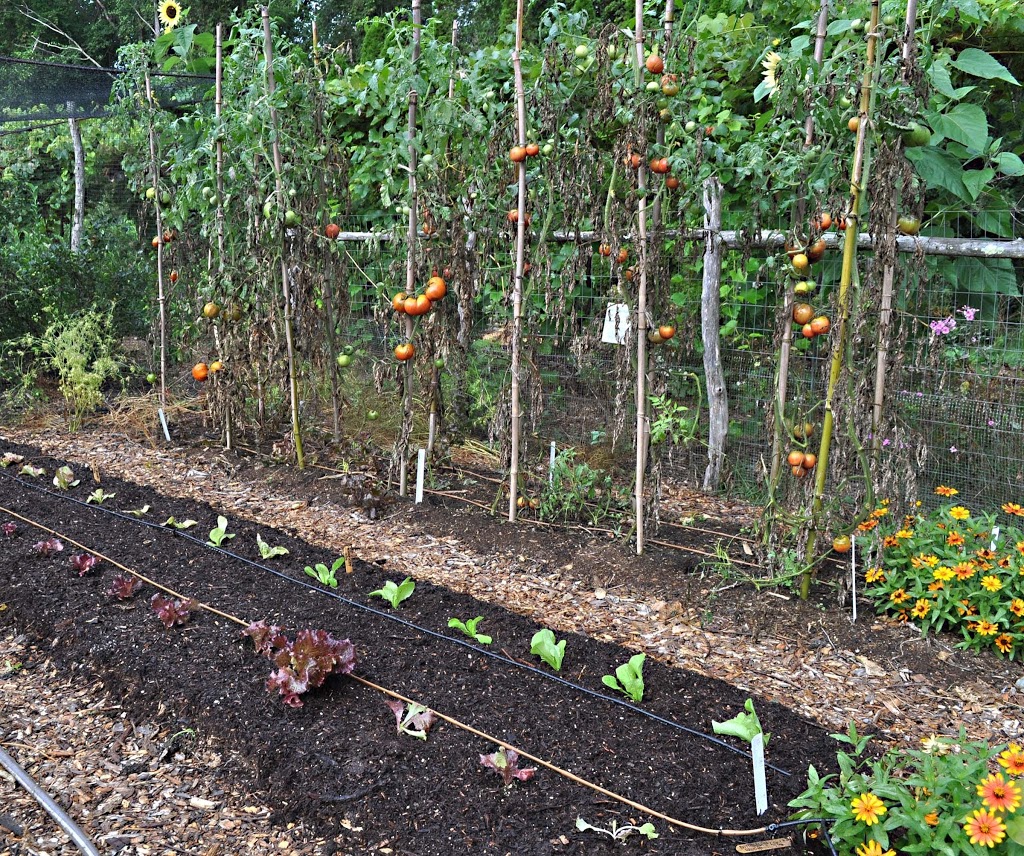

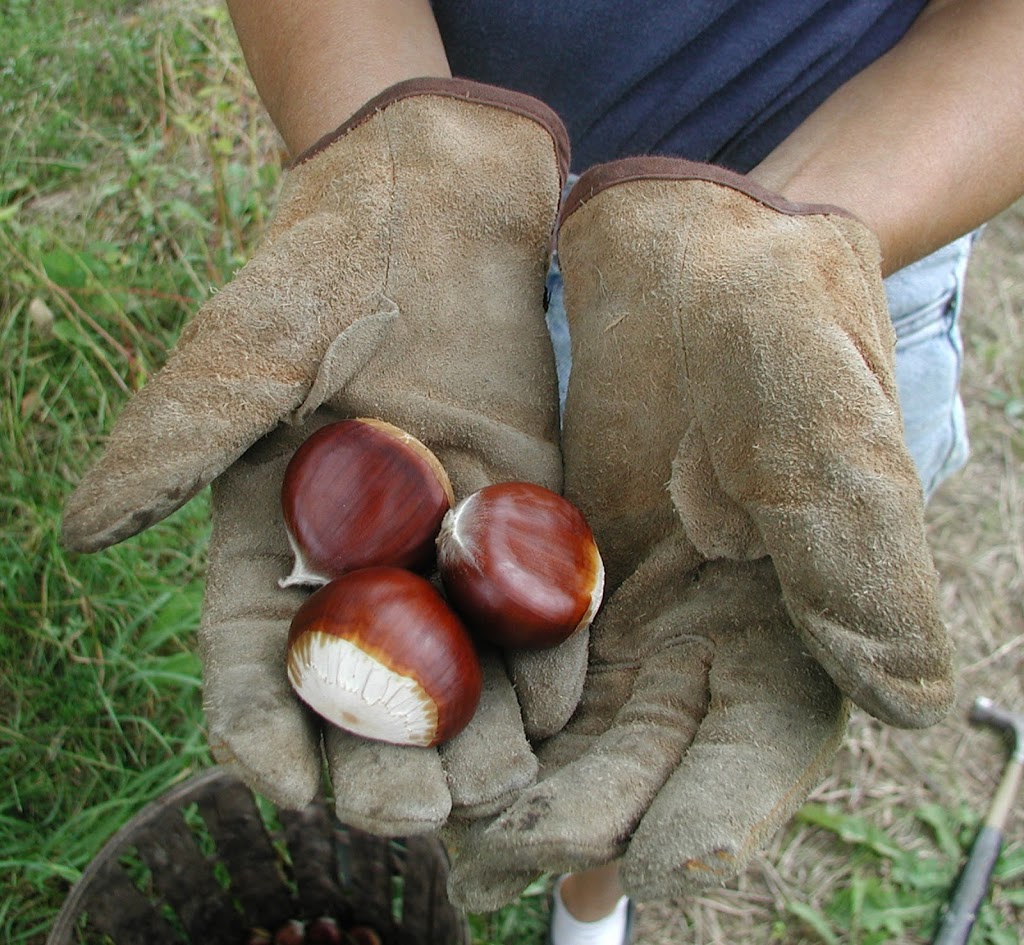

Hi Lee! Thank you for the advice on chestnuts – my neighbor is in her 80s, and she has two lovely Chinese chestnuts (not sure of the variety) that have to be 50+ years old. They’re very productive, and though I haven’t examined them closely, they seem to be blight-resistant too. She very generously invites us to take as many of the nuts as we can get to before the squirrels!
The only downside are those hulls. We’ve tried to pick them up since the squirrels end up bringing them to our yard and endangering our care feet. But they smoke a lot when they burn (at least fresh), and they’re still prickly after chipping. Do you do anything with your hulls, or are your trees far enough from your well-traveled paths that they don’t pose a threat?
My chestnuts are far from any well-travelled path.
The ideal arrangement!
We have a grove of American/Chinese hybrid trees which are doing well but the nuts are always full of maggots from a chestnut pest. Any ideas for combating this? Our trees are 40 feet high and in diameter.
Pick up nuts from the ground every day during harvests season and then either freeze them (which kills the nut so it won’t store well unfrozen) or else give a hot water treatment of 120°F for 20 minutes. I’ll be describing my arrangement for the latter in more detail later in the season.
Good Morning Lee,
About a year ago I met a woman who was making her own skin salve and she encouraged my husband to try it, with some noticeable clearing up of his psoriasis. I started reading more about it and making my own salves, trying other ingredients and at this point we are seeing huge results, especially after adding Lanolin. After reading your article my thought was, “Why not use a herbal salve on a ailing tree?” (Plants Healing Plants) Using the “Base” oils, it can be applied to a tree with a paintbrush. I’ve tweaked this list from the one I’m using in my husbands salve which is: Castor Oil (base), Coconut oil (Base),100% Pure Lanolin, Vitamin E, Tea Tree Oil, Lavender Oil, Rose Oil, Arnica Oil, Chamomile Oil, and Bees Wax, to something that might work well for a tree. With your knowledge you might know of something else that would benefit in the ingredients but this is a good start.
(Ingredients)
Castor Oil (base), Coconut oil (Base), 100% Lanolin, Tee Tree Oil, Neem Oil, Eucalyptus Oil.
Castor oil: Also known as “Palm of Christ” and its antifungal properties, stimulates tissue growth so that a barrier can be formed between the wound and the environment, decreasing the risk of infection. Ricinoleic acid, the main fatty acid found in castor oil, has impressive anti-inflammatory properties.
Lanolin: A wax secreted by the sebaceous glands of wool-bearing sheep and extracted from their wool, its highly emollient properties and ability to prevent water loss.This is like a protective skin.
Tea Tree oil: The oil possesses antibacterial, anti-inflammatory, antiviral, and antifungal properties. Tea tree oil is commonly used to treat acne, athlete’s foot, lice, nail fungus and insect bites.
Eucalyptus Oil: The Australian aborigines used eucalyptus leaves to treat wounds and prevent infection. (Antiseptic: relating to or denoting substances that prevent the growth of disease-causing microorganisms.) The diluted oil is used to fight inflammation and promote healing.
Neem Oil: Neem oil has a wide history of use as a folk remedy and has been used to treat many conditions. Although it has a harsh odor, it’s high in fatty acids and other nutrients. Neem oil contains many ingredients that are extremely beneficial to the skin. Some of those ingredients include:
• fatty acids (EFA)
• limonoids
• vitamin E
• triglycerides
• antioxidants
• calcium
(P.S. Last fall I applied a “salve” to my fruit tree pruning cuts and it made a huge difference in the healing.)
The problem with chestnut blight isn’t just wound healing; it’s a fungal infection. So I am skeptical, although I’d be happy to hear of others’ results who might try this or some other concoction. Generally, pruning wounds heal best without any type of salve. Actually, they don’t really “heal” at all. Instead, healthy tissue overgrows the wound to eventually seal it off from the the environment.
Interesting read, Thank you. I remember you having an Eaton chestnut. Whatever happened to that tree? Did the nuts taste not-so-good to you? What do you think of Marigoule compared to Colossal nuts; I would guess they’re similar but a tad smaller? Thank you again.
I got rid of most of my Chinese and hybrid Chinese chestnuts because of staining of the Japanese varieties, including Colossal. Once the new Japanese hybrids start bearing, I cut down the remaining Chinese. (Although I do sometimes fear that I perhaps should get rid of all the Japanese hybrids and grow only the best varieties of Chinese hybrids even if their nuts are smaller.)
Marigoule compares very favorably with Colossal. My yield has been low because Colossal can’t pollinate othe varieties.
From what I have read, Marigoule is the most blight resistant Eur/Jap hybrid known. Some researchers in Turkey tested all the Eur/Jap hybrids available in Europe and Marigoule was by far the most resistant. I have also read on the GrowingFruit forum that M. Nave also like Marigoule among the best of that type of hybrid.
I understand your dilemma about growing all Eur/Jap hybrids or all Chinese and Chinese/Jap hybrids but not mixing them. Hopefully your new trees start producing soon; they ought to since they’re grafted. Best of luck & Thank you again.
I know of three trees in central Wisconsin, 10 to 14 inches in diameter at the base.
One developed a fungal infection on the trunk. I punched holes into the ground
all around the tree from trunk out to the drip line. I used a spading fork. Then I poured a quart or two of Azomite mineral supplement into the holes. That was two years ago. The canker is much improved, more like a scar now than an infection, and the tree thrives. I would like to know if anyone has tried to stave off/knock out the chestnut blight with a massive dose of minerals? Could a nutrient burst, possibly a dose of some trace element, bump up the tree’s immune system sufficiently to defeat the fungus? I do not know the lineage of the trees.
I would love to have some feedback on this.
As always, I’m skeptical. What were the symptoms of the infection? Perhaps it was not chestnut blight.
Hello Leigh, I am a chestnut grower in Lebanon (The country). Up here on Mount Lebanon we grow lots of fruits and pines. Some of my chestnut trees have been succumbing to ink disease (Phytophthora) – at least it apears like that. Do you have that problem? I am now switching to Marigoule, Maraval and the like and also starting to plant on raised mounds and sloping terrain.
All the best
Rida (Rudy) Nuwayhid
I’ll bet you can grow lots of fruits and nuts that I wish I could grow, such as pomegranates, olives, etc. The nuts of my chestnut trees get ink staining, which is different from what you’re describing. Mine is caused when Japanese chestnuts of their hybrids get pollinated by Chinese chestnuts or their hybrids.
Thanks for your reply. I fo have both chinese chestnut trees and both euro-japanese hybrids as well as castanea sativa seeibg trees sll near each other. I wonder what emetges from cross pollonation. Thsnks again.